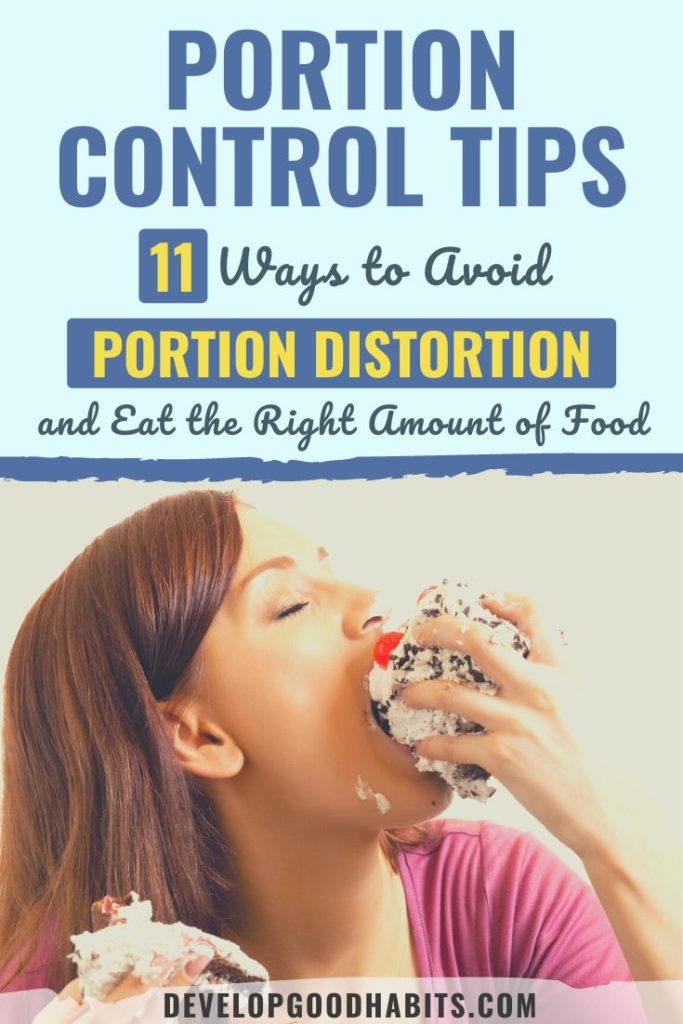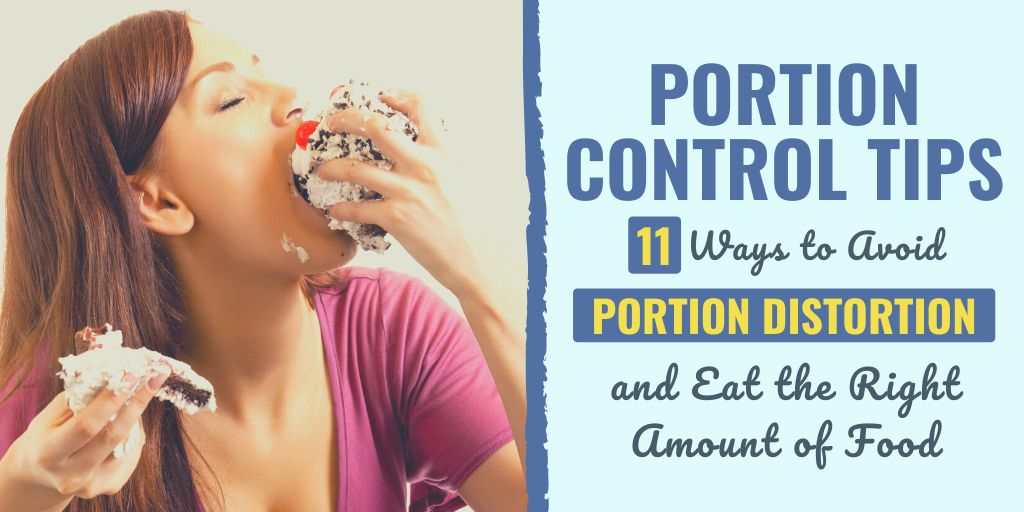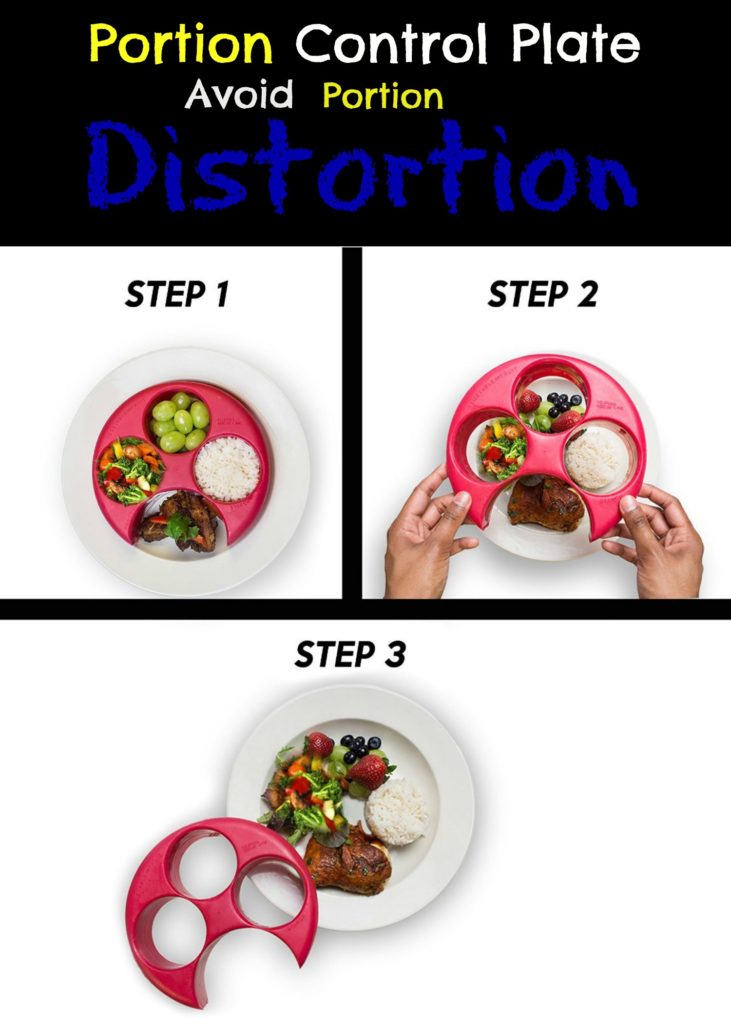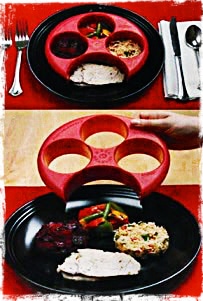There might be affiliate links on this page, which means we get a small commission of anything you buy. As an Amazon Associate we earn from qualifying purchases. Please do your own research before making any online purchase.
If you want to lose weight, there are all sorts of fad diets out there.
You could try plans like: Low Fat, Low Carb, Mediterranean or Calorie Restrictive.
There are many differences between these diets, but they all have something in common. At their core, they recommend adding portion control into your daily routine.
Now, I’m not really a fan of any specific “diet” because most of them aren’t effective in the long-term. However, I do believe that developing the habit of portion control can have a positive impact on your ability to lose weight and maintain a healthy lifestyle.
Side bar: One simple health habit you can build is to drink this superfood green drink, which gives you a boost of energy and supplies your body with the nutrients it needs to get through the day. (You can also read the review of it here.)
In this article we will discuss 11 portion control tips to help you lose weight, maintain healthy eating, and create a habit of having a normal portion size with each meal.
11 Ways to Build the Portion Control Habit
Focus on Portion Control for 30 Days
Make portion control your one habit change for at least a month. “One habit at a time” should be your focus and mantra.
Many people attack weight loss like it’s part of a multi-front war campaign. They diet. They start an exercise routine. They eat less. They eat healthily. They try to get the right amount of sleep. They reduce calorie intake.
Don't get me wrong, all of these strategies are great. But it’s impossible to add them all at once. What usually happens is ego depletion sets in; you start to backslide and ultimately give up because it’s almost impossible to perfectly change multiple habits at the same time.
Plan Your Portion Control Habit
Every habit change needs a plan. That’s why you need to plan for the following situations:
Make a plan for the portion control habit. Ultimately this will be the difference-maker when it comes to permanently adopting this routine.
Learn Serving Sizes
One of the very best portion control tips is learning exactly what the proper serving size really is.
These days. most serving sizes are ridiculously large. Because of this most people tend to underestimate serving sizes these days. That’s why it’s important to learn how to read food labels.
Unfortunately, manufacturers purposefully make it hard to understand their labels because the more you eat, the more money you’ll spend on their products.
At some point, it’s worthwhile to understand the metrics behind serving sizes. This will help you to visualize what’s “enough” food for you.
As an example, here are a few portion sizes that can help with your visualization efforts:
- 3 ounces (meat or fish) = deck of cards
- 1/2 cup is one ice cream scoop
- 1 cup of brown rice is the size of a closed fist
Most people think they know a portion size, and most people are wrong. The super-sized mentality has skewed our viewpoint on what’s considered normal. By understanding portion sizes, you’ll know how much is appropriate to eat at each meal.
The example above is a 9-inch plate. A size much closer to a full plate being the “proper” size for meals.
Eat more Vegetables Fruits and Other Healthy Alternatives
I’m sure you remember your mom saying this. I admit it, I’m not crazy about most vegetables; but they’re important for healthy eating.
One of the keys to mastering portion control is to eat lots of vegetables throughout the day. Why? Because vegetables are: low in calories, packed with vitamins, and filled anti-oxidants and minerals. When it comes to food portion control, you can almost ignore large servings of veggies because they have a low amount of calories when compared to other foods.
So eat more foods like, veggies, brown rice, fruits, and unprocessed grains, and ice cream, chips, steaks and processed foods.
Use Portion Control Plates
Since 1980 the average plate size has increased from 9 inches to 12 inches. That’s an increase of 33%. A simple solution is to reverse this trend is to buy a 33% smaller plate. Fill it up all you want, piling on the veggies and salad. That way you’ll be full, satiated and eat less.
Don't want to buy new plates? You can do the same thing with a portion control plate tool. Simply lay it over your plate and fill up each section with the proper food portion
[See the best portion control plates]
Prepare Meals at Home
Restaurants give huge portions that taste great; but are filled with an insane amount of calories. Sure, the occasional dinner out can be a treat. But for the majority of the time, it’s far better to prepare meals at home.
Eating at home also means cooking your own meals. It’s tempting to throw a T.V. dinner into the microwave, but most of these are filled with junk calories. Plus they contain preservatives and don’t have a substantial amount of vegetables. The simpler solution is to cook your own food, which allows you to control and monitor all aspects of the food you’re eating. [54 easy homemade meals for two]
Sneak in Veggies
Many people have a tough time eating their veggies. The trick is to find the veggies that you like and try to “sneak” them into the dishes that you prepare. Just add a few extra veggies into a recipe, to turn a non-veggie dish into something that’s healthier.
For instance, sneaking in veggies is a particularly effective strategy when preparing sandwiches, soups, and casseroles.
Pack Your Leftovers Immediately
After loading up your plate at mealtime, immediately pack away the leftovers. If you are really hungry, you can always unpack your leftovers later. But this simple habit will remove the likelihood of “eating out of convenience.” By packing the food away, you’ll increase the chances of stopping after a single-serving meal.
One great way to store leftover is portion control containers, which give a great way to measure and store leftovers. [See the best portion control containers]
Turn a Single Meal Out into 2 Meals
If you do go out to eat, only eat half the plate. In fact, ask your waitress/waiter to bring a “to-go box” the moment they bring you a meal and then put half away for a future meal. Most of the time, you can’t control the “badness” of a restaurant meal, but you can at least reduce the total number of calories. [See freezer meal ideas for multiple dinners]
Use Oil Sparingly
When cooking you sometimes need oil, but use it sparingly and try healthy alternatives like olive oil or safflower oil. Using less oils help significantly in losing weight
Prepare Single Serving Packages
If you cook large amounts of food, separate the leftovers into single-serving packages. This makes it easy to grab a sensible food portion sized lunch for work or school.
Final Thoughts on Portion Control
Most “diets” don't work in the long-term. What does work is following a plan that incorporates sensible eating, minimizing “junk food” adding healthy foods like vegetables, food portion control, and adding in a simple workout routine? Make it a point to incorporate these 11 strategies over the next 30 days and you’ll be on the road to forming the portion control habit.
Now it’s on to you.
Do you have any portion control tips you’d like to share? How have you fared with monitoring your healthy eating habits in the past? What has worked (or not worked) for you? Let us know.
Finally, if you need more guidance on how to start on a healthy diet, learn how to set SMART goals for nutrition here.





My portion control tip is: eat ten times a day.
I used to eat 3 then 4 hefty meals a day. I changed it when I started my weight loss. Now I eat 2-3 fruits in the morning (separately), then first morning meal (let’s call it a breakfast), then a cottage cheese, then small lunch, then another small lunch. And in the meantime I stuff myself with raw veggies (usually carrots).
In the realization that I overeat a calorie tracker with photos was very helpful, too. I could see how caloric is a small sandwich or big carrot etc. Unfortunately I don’t know a good and free one in English.
And food journal was helpful, too.
Michal,
You make some great points here:
1. lots of meals a day. If they are SMALL like your are this can be a good idea. Grazing like this keeps you from being hungry. I have heard some people say it gives a metabolic boost too… but I read at least one scientific experiment that says that is not true. So not sure how I land on the “metabolic” side of this issue. But eating more often (and smaller) certainly can work for some people to keep them from bad snacking.
2. Tracking. As you know I am a tracking fanatic. Food logs and all that is a really helpful, perhaps even essential. YOu never know how much you take in until you track it. Things like fats vs carbs vs protein is certainly part of weight loss/control but ultimately it all boils down to simple: what you eat
Great article buddy!! I love how you cut right to the core of the issue. There’s so much bullshit out there when it comes to diet recommendations, food fads and the rest, but every reasonable, credible person I’ve talked to has said what you wrote about; that it’s all about how many calories you consume versus how many calories you spend.
I especially love habit #4. A rule I have for myself is that I restrict consuming some foods (which does eat up some willpower, I’ll admit), but allow myself to eat as many vegetables as humanly possible.
I’ll be sending this article to a few people. Great stuff.
Thanks Chris! Glad you liked it.
I agree, there is a metric ton of BS out there. Usually when someone is trying to sell some specific solution. While some of the information IS helpful and worth listening to, ultimately Calories in vs calories out is the most important thing.
On a BS side note. I was watching one of those horrible “800 pound lady” shows the other day. The lady had to loose 100 pounds so she could be healthy enough to get bariatric surgery. When she went back to her doctor she had gained a hundred pounds. She had fallen for some magic fairy dust stuff that sprinkled on food would make it free to eat as much as you wanted. Of course it didn’t work. It is kinda funny, except for the part in the end where they tell you she died before filming. The BS out there runs deep and thick … and it can actually be dangerous.
Most people know what they need to do, putting it into action is the hard part.
That’s the key right there, I think. Everyone in the world knows 10 things they can do, starting right now, to become healthier, fitter, smarter, and everything else, but that knowledge is naturally useless if you don’t act on it.
That’s a pretty tragic story.. I wouldn’t know it what it would be like since I live in a relatively healthy city, but from what I understand, in some cities you have to do basically everything in your power not to become obese. When your friends, family, and everyone you know eats fast food, has terrible exercise habits, and all the rest, it’s pretty difficult not to adopt those habits yourself, especially when your city is built around those habits. Terrible TV shows aside, it’s a pretty complex problem.
You’ve probably ran into the same research, but Kelly McGonigal has written quite a bit about how contagious some habits are–fascinating stuff.
Yes! Most diets don’t work in the long-term. I don’t know how often I’ve told people this, but they still go out and try the latest fad diet or an old one that people still occasionally do. I’ve known way too many people who bounce from diet to diet hoping that the next one will work. Usually it doesn’t. I like your approach more – that might be because it’s what I (kind of) do. I try to get my veggies in and I cook a lot of meals at home. If anything, I don’t eat enough.
Stick to smaller plates. Even if you know the trick and why it works, it will still work. I’d say start there and get those portions smaller.
Yeah, it is sad how people will be lulled from diet to diet. It is a desperate situation, that likely only makes the situation worse, since people do lose weight in these diets, but the quick weight lose is often water and some lean muscle mass. The muscle mass loss making that persons metabolism slow down -which in turn makes MORE weight gain in the future easier. A vicious cycle. Doing things right is certainly a case of “turtle and hare”. But the turtle lacks a lot of drama for people, so is often ignored.
Thanks for a great comment Steve.
One very important thing that you did not mention is to focus on real, whole, unprocessed food. I have been a proponent of the paleo diet for over 10 years, before it suddenly became popularized and pushed into the “fad” category. It has worked for me, and worked for countless people I know both in real life and on the internet. But only when looked at less as a “diet” than a template for how to eat and which foods to minimize and which to maximize. Focus on nutrition density and bio availability of nutrients in food.
When I look in most people’s grocery carts, I see so much processed junk that is very addicting. Food manufacturers purposely put flavorings and other tricks to get you to overeat that particular food. It is very, very difficult to portion control things that are addictive.
How much of a delicious ribeye could you eat at one sitting? My guess is that you quickly reach a point where, despite it’s deliciousness, you are satisfied at a reasonable portion. However, add some sort of processed carb, and you are on the road to feeling stuffed.
Veggies are okay, but I think overstated. Do some research on saturated fats and how the vilification of them changed the American diet for the worse.
Like I said, I’ve been 80/20 paleo for over 10 years. I’m 37 years old, in the top shape of my life, and rarely get sick.
When eating a whole foods diet such as paleo, preparing food ahead of time is key. This both saves time in the long run and sets you up for success. I utilize a large, upright freezer and make food up for meals ahead of time, and freeze them in labeled ziplocks. That way, during the week, I can just grab and go. Add some fruit and maybe raw veggies, and you are good to go.
Mak,
I don’t disagree with you at all. While I am not into Paleo per se, I think there is a lot of validity there AND I DO make good attempt to minimize processed foods. In fact I have a post a few months ago about minimizing processed foods.
My thinking was to try to just include things that deal with portions on this, but you do make a valid case for lowering processed foods being a means of portion control too. I guess my thinking is to try to set people on a better path without TOO much wholesale change.
Anyway, even you missed one good reason I just thought of reading through your (great) comment. Protein actually is far better filler for satiety purposes, so eating more protein makes the cravings for food spread out further apart.
As for veggies. Well I disagree with you a little there. From what I have read it was the “American Standard diet” with the pushing of a couple starches a day that was to blame. MOST veggies are very low calorie/high volume food, so they fill people up. Where people fall into traps is trying to eat vegan meals, because THOSE are often packed with hidden sugars. People think they are eating healthy sometimes and not. So I agree it is not as clear cut as “Eat vegetables =get healthy” but MOST people do not eat nearly enough.
Anyway, even though I am not into Paleo exactly, I do see a lot of benefit in more protein, (LOTS) less carbs and avoiding processed food most of the time. I think these are all great things!
Thanks for adding some awesome input!
Hi, thanks for the interesting article.
I was recently in Asia for holidays and in this part of the world they tend to serve small portions of a lot of things. I took the cue and bought small, rectangular plate and a bowl in a bight blue that I really like.
I have them in my office so when I eat there I use them, they put me in a good mood because I like the color and are small, so I tend to just fill them with the food I brought and if I brought too much I keep it for the following day. At least one of the two is only filled with vegetables.
I also use chopsticks: the size of the bites is smaller and it’s harder for me to use them, so I eat slowlier than usual and recognize when I am full.
Finally, I bought a bento box to transport food (I don’t eat from it because I don’t enjoy eating from plastic containers): at first it looks really small but I always find that I am satisfied about my meal, so it must contain plenty enough for me. I know that when I was using bigger containers I had bigger portions.
Greetings from Italy!
Wow !!! Your Blog tips are really appreciable i really like these. Fitness is the more important thing in our busy lifestyle. If you need a happy life then you need a healthy and active body.
Thanks for your great article. Actually, To lose weight, you need to burn more calories than you consume, which inevitably means one thing: portion control. … “You don’t want to feel like you’re on a diet, but you have to eat fewer calories.” Here are 14 easy ways to cut portions, trim calories, and lose fat without counting the minutes until your next meal.